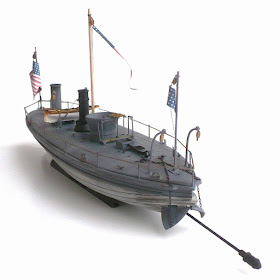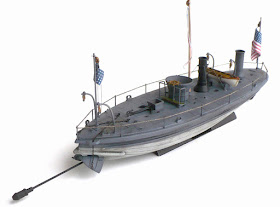Here are some images of Cottage Industry Models 1/96 scale USS Spuyten Duyvil Union Ironclad ship.
From Wikipedia"
During the American Civil War, the Union Navy suffered heavy losses from the explosion of Confederate torpedoes.
This experience prompted the Union Navy to design and build vessels
capable of using this new weapon. One effort along this line resulted in
a screw steam torpedo boat originally called Stromboli, but later called Spuyten Duyvil, after the Spuyten Duyvil area in New York City.
Stromboli was designed by the Chief Engineer of the United States Navy, Captain William W. Wood, who supervised her construction at New Haven, CT, by Samuel M. Pook.
The contract for her construction was dated 1 June 1864. Confirmed
records of her launching and commissioning have not been found – though
period records indicate that she was completed in only three months. On
19 November 1864, the boat was renamed Spuyten Duyvil. On 25 November 1864, she successfully fired two torpedoes. Late in November 1864, Commodore Charles Stewart Boggs was placed in charge of Spuyten Duyvil, Picket Boat No. 6, and steam tug John T. Jenkins which had been chartered to tow the former vessels to Hampton Roads, VA. Upon arriving at Baltimore, MD
on 2 December, Boggs turned the vessels over to Commodore T. A. Dornin
who placed them under First Assistant Engineer John L. Lay for the
remainder of the trip to Hampton Roads. The vessels arrived at Norfolk, VA on 5 December.
The torpedo boat was ordered up the James River a week later to help assure Union control of that vital waterway during General Ulysses S. Grant's drive on Richmond, VA.
She arrived at Akin's Landing on 15 December, and she operated on the
upper James slightly below the Confederate obstructions through most of
the remaining months of the campaign. A highlight of her service came on
the night of 23/24 January 1865 when the Confederacy's James River Squadron launched its downstream assault on the Union squadron. During the ensuing Battle of Trent's Reach, Spuyten Duyvil supported Onondaga, the only monitor then on the river.
After General Robert E. Lee evacuated Richmond, Spuyten Duyvil used her torpedoes to help clear the obstructions from the river. Her work made it possible for President Abraham Lincoln to steam up in Malvern and, after Rear Admiral David Dixon Porter's flagship ran aground, to be rowed in a launch safely to the former Confederate capital.
Following the end of the war, Spuyten Duyvil continued to clear obstructions from the James. She then returned to the New York Navy Yard
where she was placed in ordinary in 1866. In the years that followed,
she was used for developmental work and was modified with many
experimental improvements. The ship disappeared from the Navy list in
1880.
In this case, as in the common use of the term in the 19th century, torpedo refers to a device sometimes rigged as a spar torpedo that would now be considered to be a type of naval mine, not being the self-propelled device (called a locomotive torpedo) common in the 20th century.








That is really cool. Nice ship of the era.
ReplyDeleteDave
Beautiful model.
ReplyDeleteHe knew HL HUNLEY of the confederation.
It must be recognized that the invention of the propeller torpedo would represent an authentic revolution in the marine war.
Thanks Dave!
ReplyDeleteEn realidad, el torpedo autopropulsado fue inventado por Robert Whitehead, un ingeniero británico en 1866. Un año después de la guerra civil estadounidense terminó.
ReplyDelete